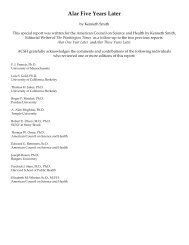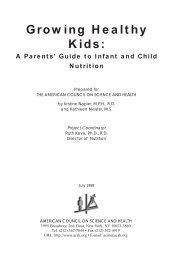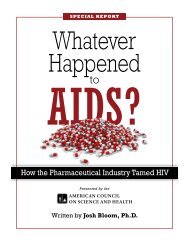The Role of Beef in the American Diet - International Meat Secretariat
The Role of Beef in the American Diet - International Meat Secretariat
The Role of Beef in the American Diet - International Meat Secretariat
You also want an ePaper? Increase the reach of your titles
YUMPU automatically turns print PDFs into web optimized ePapers that Google loves.
<strong>The</strong> <strong>Role</strong> <strong>of</strong> <strong>Beef</strong> <strong>in</strong> <strong>the</strong> <strong>American</strong> <strong>Diet</strong><br />
<strong>of</strong> <strong>Meat</strong> Group foods daily, while women eat an average <strong>of</strong> 4.0 ounces<br />
(29). Thus, <strong>the</strong> typical man’s consumption <strong>of</strong> foods from this group is<br />
with<strong>in</strong> <strong>the</strong> recommended range, while <strong>the</strong> typical woman’s <strong>in</strong>take is<br />
lower than recommended.<br />
<strong>The</strong> Fats <strong>in</strong> <strong>Beef</strong><br />
Many people believe, <strong>in</strong>correctly, that all <strong>of</strong> <strong>the</strong> fat <strong>in</strong> animal foods<br />
is saturated, while all <strong>of</strong> <strong>the</strong> fat <strong>in</strong> plant foods is unsaturated. Actually,<br />
no fat is 100% saturated or unsaturated; fats from both animal and vegetable<br />
sources <strong>in</strong>clude both types <strong>of</strong> fatty acids, <strong>in</strong> different proportions.<br />
Figure 2. Fatty acids <strong>in</strong> beef<br />
Figure 2 shows <strong>the</strong> percentages <strong>of</strong> <strong>the</strong> total fatty acids <strong>in</strong> beef that<br />
consist <strong>of</strong> saturated, monounsaturated, and polyunsaturated fatty acids.<br />
As <strong>the</strong> graph <strong>in</strong>dicates, about half <strong>of</strong> <strong>the</strong> fat <strong>in</strong> beef is monounsaturated<br />
(<strong>the</strong> same sort <strong>of</strong> fat found <strong>in</strong> olive and canola oils); monounsaturated<br />
fatty acids do not have detrimental effects on cholesterol levels. <strong>Beef</strong> is<br />
<strong>the</strong> s<strong>in</strong>gle largest source <strong>of</strong> monounsaturated fatty acids <strong>in</strong> <strong>the</strong> U.S. diet,<br />
account<strong>in</strong>g for 12.9% <strong>of</strong> total monounsaturated fat <strong>in</strong>take among U.S.<br />
adults (5). Even <strong>the</strong> saturated fatty acids <strong>in</strong> beef, which make up about<br />
45% <strong>of</strong> its total fat content, are not all cholesterol-rais<strong>in</strong>g. As Figure 3<br />
shows, about one-third <strong>of</strong> <strong>the</strong> saturated fatty acid content <strong>of</strong> beef consists<br />
<strong>of</strong> stearic acid, which nei<strong>the</strong>r raises nor lowers cholesterol (30).<br />
15










